H.M. The Tower of London
Location: Tower Hill ADMISSION INFORMATION The Tower of London Visting Information.
HINT: When you've completed your visit to the Tower, you can take a sightseeing mini-cruise from Tower Wharf up the Thames to Westminster Pier for about £5.00. The last boats leave at approximately 16:00.
|
 The Tower
The Tower
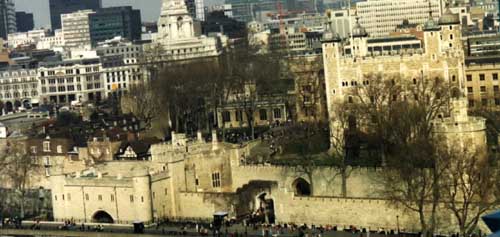 The Tower of London as seen from the Tower Bridge walkways
The Tower of London is the most visited and best known of England's castles. Many people recognize it as a prison; however, the Tower has served numerous purposes including palace, prison, garrison, treasury, fortress and execution site since its construction around 1078. It has housed the Crown Jewels of England for the past 600 years.
The Tower of London is actually a concentric-type castle and by the 13th century, it had more or less the form it has today. The inner (built by Richard I and Henry II) and outer wards (built by Edward I) are separated by two fortified curtain walls and the entire complex is encircled by a deep moat. The irregular, square outer wall is divided from its counterpart by a narrow lane. 13 separate towers make up the Norman fortress, including the centrally located White Tower, which likely gave the castle its name. Tower Wharf stands between the moat and the River Thames. In all, the castle encompasses 84 acres of land.
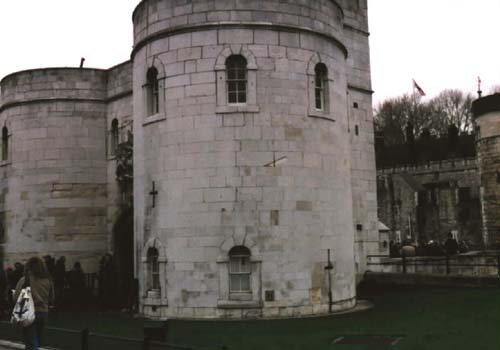 The tourism entrance to the Tower |
 History
History
William, Duke of Normandy, ordered a stronghold to be built upon his seizure of London. The Tower has since been added upon by subsequent monarchs until it became the 84 acre fortress of today. The Caen stone White Tower, the central point of the complex, was probably the source of the name. It was built into an existing Roman wall and was 90 feet high with walls up to 15 feet in width. It served as the keep for the Conqueror, his soldiers, servants and court. Henry III is credited with building the curtain walls and constructing his own water gate, which later became known as the infamous "Traitor's Gate."
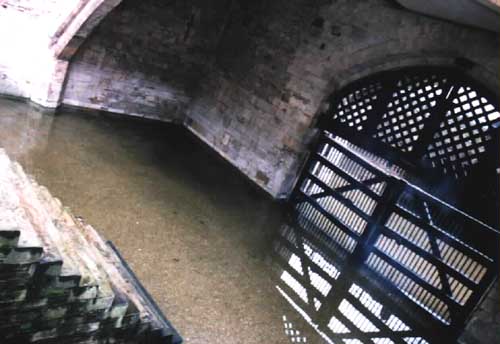 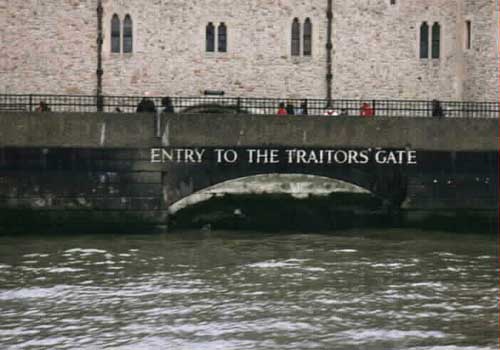 Wakefield Tower was also built during the same period between 1189 and 1306. The Tower's "healthy" appearance today is largely due to the restoration efforts of Anthony Salvin. While the Tower is probably the most well known for its use as a prison and execution site, it is important to note that it has served also as a royal residence and palace, arsenal and munitions factory, treasury and mint, garrison and library. Prisoners entered the Tower through the water gate (Traitor's Gate) in St. Stephen's Tower by barge and were led to their chambers to await sentencing, ransom, incarceration or execution. The Tower's prisoners varied from the rich and famous (or infamous, depending on your point of view) to the petty thief. If a prisoner faced execution, it would be conducted either on Tower Hill (usually by hanging in a public forum) or on Tower Green (usually reserved only for noblemen and women.) Sometimes nobles to be executed within the Tower walls were provided with a French swordsman to swiftly perform the grim task of decapitation. Execution by a henchman with an axe often required several swings- hence a painful and gruesome death for the condemned. Notable prisoners who lost their heads on Tower Green are Anne Boleyn (1536,) Henry VIII's second wife and mother of Elizabeth I, Katherine Howard (1542,) Henry VIII's fifth wife, Lady Jane Grey (1554) and the Earl of Essex. It is believed that Richard III was responsible for the murder of his nephews, the Princes, in the Bloody Tower, which also served as jail for Archbishops Cranmer and Laud in addition to Sir Walter Raleigh. Henry IV was allegedly murdered by Richard, Duke of Gloucester in Wakefield Tower, which now houses the Crown Jewels. The Beauchamp Tower walls are carved with inscriptions made by those prisoners awaiting their trials or deaths. The Bowyer Tower still contains the instruments of torture. The Royal Chapel of St. Peter and Vincula, one of London's oldest churches, houses the unshriven remains of those executed in the Tower, including Thomas More and the Jacobite lords who died between 1746 and 1747. Altogether, there are 13 towers that comprise "The Tower of London," each with its own individual story to tell.
 The actual wooden block on which many famous prisoners lost their heads, including Anne Boleyn, second wife of Henry VIII and mother of Elizabeth I.
The Tower is also famous for its ravens. They are tended by the crimson and black-costumed Beefeaters, officially known as the Yeoman Warders, who have guarded the Tower since 1485. It is said that should the ravens ever leave, the Tower of London will fall. The ravens' wings are therefore kept neatly clipped.
 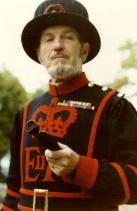 A raven on the Tower Green (left) and Beefeater (right) |
 History
History
Links to my other London Attractions pages
Tower Bridge Experience Official Armouries Site Official St. Katharine's Docks Website Official Royal Family Website
 All photographs ©1997-2004 M.D.Cerny unless otherwise indicated. Contact me prior to reproduction/use in a public forum to obtain my permission. Please leave your contact information and the URL where the photograph(s) will be used (if applicable) via the email link above. In exchange for their free use, a small, name text link to my site is required on each page where my photographs are posted. Click here for full legal copy and information about obtaining permission to use my photography. |